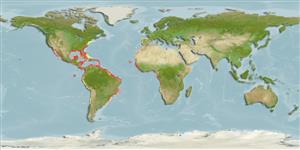分类 / Names
俗名 | 同种异名 | Catalog of Fishes(属, 种) | ITIS | CoL | WoRMS | Cloffa
Elasmobranchii
板鳃亚纲 (鲨鱼与 鱼) (sharks and rays) >
Orectolobiformes (Carpet sharks) >
Ginglymostomatidae (Nurse sharks)
Etymology: Ginglymostoma: ginglymus (Gr.), hinge; stoma (Gr.), mouth, presumably referring to how corner of mouth has a hinged appearance (See ETYFish); cirratum: Latin for having tendrils, referring to elongated nasal barbels (See ETYFish).
More on author: Bonnaterre.
Environment: milieu / climate zone / depth range / distribution range
生态学
海洋; 半咸淡水 礁区鱼类; 深度上下限 0 - 130 m (Ref. 43278), usually 1 - 35 m (Ref. 40849). 亞熱帶的; 44°N - 35°S, 122°W - 10°E (Ref. 43278)
Western Central Atlantic: Rhode Island to southern Brazil (south to Rio de Janeiro), including Gulf of Mexico and Caribbean coasts, although (exceptionally from Rhode Island to Texas), Bermuda; Eastern Central Atlantic: Cape Verde Islands, Senegal, Cameroon to Gabon, and rarely north to Bay of Biscaye, France (ref. 43278). Populations in eastern Pacific refer to Ginglymostoma unami Del Moral-Flores et al., 2015 (Ref. 113902).
西大西洋: 羅德島州,美國到巴西南部, 包括墨西哥灣與加勒比海,安地列斯群島。 東大西洋: 維德角到加彭; 偶而被發現於法國。 東太平洋: 加州灣與墨西哥的下加利福尼亞南部到祕魯。 近親魚種被發現於印度洋。
Length at first maturity / 大小 / 重量 / 年龄
Maturity: Lm 235.0, range 230 - 240 cm
Max length : 430 cm TL 雄鱼/尚未辨别雌雄; (Ref. 96339); common length : 304 cm TL 雄鱼/尚未辨别雌雄; (Ref. 247); 最大体重: 109.6 kg (Ref. 40637); 最大年龄: 25 年 (Ref. 72467)
简单描述
检索表 | 型态特徵 | 形态测量图
背棘 (总数) : 0. Moderately long barbels, nasoral grooves present but no perinasal grooves, mouth well in front of eyes, spiracles minute, precaudal tail shorter than head and body, dorsal fins broadly rounded (the first much larger than the second and anal fins), caudal fin moderately long, over 1/4 of total length, yellow-brown to grey-brown in color, with or without small dark spots and obscure dorsal saddle markings (Ref. 247). Head blunt, mouth inferior, pair of conspicuous barbels between nostrils (Ref. 26938).
中等长度的触须 , 鼻沟存在的但是没有鼻孔缘的凹槽 , 嘴在眼正前方, 呼吸孔细小的, 肛前尾短于头部与身体, 背鳍宽广地圆的 (第一个比第二背鳍与臀鳍大很多), 尾鳍中等长度的, 超过全长中的 1/4, 黄褐色到灰褐色颜色, 具有或者没有小的深色斑点与暗的背部鞍状斑纹.(参考文献 247) 头部钝的, 嘴下方的, 在鼻孔之间的成对显着的触须.(参考文献 26938)
Found on continental and insular shelves. Solitary (Ref. 26340) and sluggish fish, often encountered lying on the bottom (Ref. 9987). Nocturnal, feeding on bottom invertebrates such as spiny lobsters, shrimps, crabs, sea urchins, squids, octopi, snails and bivalves, and fishes like catfishes, mullets, puffers and stingrays. Ovoviviparous with 21 to 28 young in a litter (Ref. 9987, 43278). Kept in captivity for researches. May attack humans if they are molested or stepped upon accidentally. Edible, but mainly valued for its hide, which makes extremely tough and durable leather (Ref. 9987). Common over shallow sand flats, in channels, and around coral reefs; young may be found among prop roots of red mangroves (Ref. 26938).
栖息于大陆架与岛屿棚了。 一种独居性 (参考文献 26340) 与缓动性的鱼, 时常见到了栖息于底部。 (参考文献 9987) 夜行的, 吃底栖无脊椎动物例如棘龙虾,虾,螃蟹,海胆,乌贼,章鱼,蜗牛与二枚贝 , 与鱼例如鲶鱼,乌鱼,河豚与 。 卵胎生的具有 21 到 28 幼鱼在一胎。 为研究畜养于繁殖场了。 如果他们被干扰或不小心踩到,可能攻击人类。 可食用的, 但是主要的价值在它的隐藏, 这制造非常强硬而持久的皮革.(参考文献 9987) 在峡道中,普遍在水浅的沙地浅滩上, 与珊瑚礁的周围; 幼鱼可能在红色红树林的支柱根之中被发现于。 (参考文献 26938)
Life cycle and mating behavior
成熟度 | 繁殖 | 产卵场 | 卵 | 孕卵数 | 仔鱼
Ovoviviparous, with 21 to 28 young in a litter. Development of young in the uterus being sustained by a large supply of yolk. Females give birth in late spring and summer in waters off Florida. During courtship, a pair sometimes a triplet of adults engaged in synchronized parallel swimming. While on it, the male may grab one of the female's pectoral fins with his mouth which induces the female to pivot 90° and roll on her back on the bottom. Then the male inserts a clasper in her vent, and then roll on his back beside the female. Pair may break apart and depart rapidly after copulation or the male may remain motionless on the subtrate as if recovering from the mating bout (Ref. 49562). Not all attempts of males to copulate with a female nurse shark result in successful fertilization, females may employ avoidance by 'pivotting and rolling' to escape from male attention (Ref. 49562). Or females may 'lie on back' and rest motionless and rigidly on the substrate (Ref. 51113, 49562). On the contrary, females send signals of readiness to copulate with males by arching their body toward their male partner and cupping the pelvic fin (Ref. 51126, 49562). Male nurse sharks may mate with many females over several weeks (polygyny) and vice versa (polyandry) (Ref. 49562). Also Ref. 205.西大西洋: 羅德島州,美國到巴西南部, 包括墨西哥灣與加勒比海,安地列斯群島。 東大西洋: 維德角到加彭; 偶而被發現於法國。 東太平洋: 加州灣與墨西哥的下加利福尼亞南部到祕魯。 近親魚種被發現於印度洋。
Compagno, L.J.V., 1984. FAO Species Catalogue. Vol. 4. Sharks of the world. An annotated and illustrated catalogue of shark species known to date. Part 1 - Hexanchiformes to Lamniformes. FAO Fish. Synop. 125(4/1):1-249. Rome, FAO. (Ref. 247)
世界自然保护联盟红皮书 (Ref. 130435: Version 2024-1)
人类利用
渔业: 低经济; 游钓鱼种: 是的; 水族馆: 公众的水族馆
工具
特别资料
下载 XML
网络资源
Estimates based on models
Preferred temperature (Ref.
123201): 22.3 - 28, mean 25.5 °C (based on 798 cells).
Phylogenetic diversity index (Ref.
82804): PD
50 = 0.8125 [Uniqueness, from 0.5 = low to 2.0 = high].
Bayesian length-weight: a=0.00417 (0.00157 - 0.01105), b=3.08 (2.85 - 3.31), in cm total length, based on LWR estimates for this (Sub)family-body shape (Ref.
93245).
营养阶层 (Ref.
69278): 4.2 ±0.2 se; based on diet studies.
回复力 (Ref.
120179): 低的, 最小族群倍增时间4.5 - 14 年 (K=0.14; tmax=25; Fec=21-28).
Fishing Vulnerability (Ref.
59153): Very high vulnerability (90 of 100).
Climate Vulnerability (Ref.
125649): High vulnerability (65 of 100).
Nutrients (Ref.
124155): Calcium = 4.11 [0.56, 16.51] mg/100g; Iron = 0.298 [0.069, 0.838] mg/100g; Protein = 20.9 [18.7, 23.0] %; Omega3 = 0.13 [0.05, 0.32] g/100g; Selenium = 23 [6, 71] μg/100g; VitaminA = 10.8 [3.1, 40.2] μg/100g; Zinc = 0.394 [0.186, 0.863] mg/100g (wet weight);
